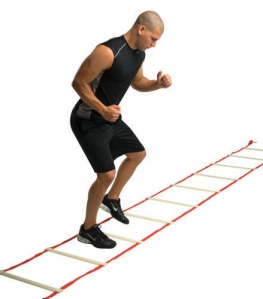Guest Blog on Foot Speed and Agility by Michael Boyle
Developing Foot Speed and Agility
Michael Boyle
A couple of threads on the StrengthCoach.com forum got me thinking about the question of foot speed and athletes. I can’t tell you how often I hear a parent or a coach ask, “How can I improve my son’s/daughter’s/ athlete’s foot speed or agility?” It seems everyone always wants the shortcut and the quick fix. The better question might be “Do you think you can improve foot speed?” or maybe even the larger question, “Does foot speed even matter?”
That begs the larger question, “Does foot speed have anything to do with agility?” I know coaches or parents reading this are asking, “Is this guy crazy?” How many times have we heard that speed kills? I think the problem is that coaches and parents equate fast feet with fast and quick feet with agile. However, fast feet don’t equal fast any more than quick feet equal agile. In some cases, fast feet might actually make an athlete slow–often I see fast feet as a detriment to speed. In fact, some of our quick turnover guys, those who would be described as having fast feet, are very slow off the start.
The problem is fast feet don’t use the ground well to produce force. Fast feet might be good on hot coals, but not on hard ground. Think of the ground as the well from which we draw speed. It is not how fast the feet move, but rather how much force goes into the ground. This is basic action-reaction physics. Force into the ground equals forward motion. This is why the athletes with the best vertical jumps are most often the fastest. It comes down to force production. Often coaches will argue the vertical vs. horizontal argument and say the vertical jump doesn’t correspond to horizontal speed, but years of data from the NFL Combine begs to differ. Force into the ground is force into the ground. In spite of what Brett Contreras may say, vectors don’t seem to matter here. The truth is parents should be asking about vertical jump improvement, not about fast feet. My standard line is “Michael Flatley has fast feet, but he doesn’t really go anywhere. If you move your feet fast and don’t go anywhere, does it matter? It’s the old “tree falling in the woods” thing.
The best solution to slow feet is to get stronger legs. Feet don’t matter. Legs matter. Think about it this way: If you stand at the starting line and take a quick first step but fail to push with the back leg, you don’t go anywhere. The reality is that a quick first step is actually the result of a powerful first push. We should change the buzzwords and start to say “that kid has a great first push.” Lower body strength is the real cure for slow feet and the real key to speed and to agility. The essence of developing quick feet lies in single-leg strength and single-leg stability work… landing skills. If you cannot decelerate, you cannot accelerate, at least not more than once.
One of the things I love is the magic drill idea. This is the theory that developing foot speed and agility is not a process of gaining strength and power, but rather the lack of a specific drill. I tell everyone I know that if I believed there was a magic drill we would do it every day. The reality is it comes down to horsepower and the nervous system, two areas that change slowly over time.
How do we develop speed, quickness and agility? Unfortunately, we need to do it the slow, old-fashioned way. You can play with ladders and bungee cords all you want, but that is like putting mag wheels on an Escort. The key is to increase the horsepower, the brakes and the accelerator. I think the answer for me is always the same. I wrote an article last year called “Is ACL Prevention Just Good Training?” In much the same way, development of speed, agility and quickness simply comes down to good training. We need to work on lower body strength and lower body power and we need to do it on one leg.
———————————–
I love ladder drills. They provide excellent multi-planar dynamic warm-up. They develop brain-to-muscle connection and are excellent for eccentric strength and stability. We do less than five minutes of ladder drills, one or two times a week. I don’t believe for a minute that the ladder is a magic tool that will make anyone faster or more agile, however I do believe it is a piece of the puzzle from the neural perspective. People waste more than five minutes on biceps curls, but we have long debates about ladder drills.
These are also a great tool to show to coaches who want “foot speed.” Sometime it’s easier to “yes” them than to argue with them. Give a guy with “bad feet” a jump rope and you get a guy with bad feet and patella tendonitis.
PSS- I have never used the term “speed ladder.” We always call it an agility ladder if we call it more than the ladder.


0 comments:
Post a Comment